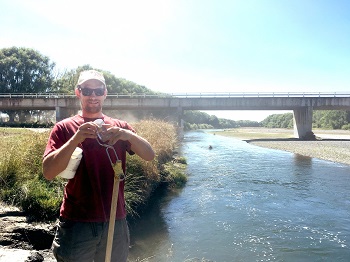I want to...
Current filter: Most popular
A to Z
Apply for a job
Biosecurity
Consents
Consultation
Contact Us
Environmental Data
Farmers Hub
Fix it or Report it
Information Request
Join an Event
Leasehold Land
Meetings
Rates
Water Metering
Have Your Say
Favourite Swimming Spots Checked for Water Quality
Published: 7 November 2018

Hawke’s Bay beaches and river spots are great places for swimming and cooling off in summer and mostly the water quality is good.
Hawke’s Bay Regional Council’s summer recreational water quality programme started this week and makes it easier for people to check on water quality so they can decide where to swim over the hot summer months.
Thirty-eight sites in popular coastal, river and lake swimming spots from Mahanga to Porangahau will be sampled every Monday, between 1 November and 31 March.
The sites have been selected through surveys of people’s favourite recreational areas, and traffic light colour coding helps make it easy to understand whether the results are good, or mean you may be best to go somewhere else.
“Water quality is generally good for swimming at our coastal beaches, but rivers can become contaminated after rainfall and people can get sick with stomach, skin or respiratory infections so that’s when you are best to swim elsewhere,” says HBRC Principal Scientist Anna Madarasz-Smith.
“There are things that people can look for before they decide to head into the water. Are there any signs up? Has it rained in the last three days? Are there large flocks of birds or animals upstream of the swimming area, or does the water look murky or discoloured? All these things may indicate that the water may be unsuitable for swimming.”
After the samples have been processed by an independent laboratory, the results are shown by late each Wednesday on the ‘Can I Swim Here’ section of LAWA - lawa.org.nz, the national environmental monitoring website.
Colour codes show the suitability for swimming – Green indicates the water quality at a beach or river is suitable for swimming, Orange for where caution will be needed because of a poor water quality history, or Red where swimming is unsuitable. These show where the samples meet national guidelines for recreational water quality.
Extra care is also needed in coastal lagoons and shallow streams. These are more likely to have high levels of contamination from faecal bacteria as the water flows through farmland or settlements with septic tanks. Some lagoons also can be home to a lot of waterfowl which add to the contamination.
“A warm, shallow lagoon or coastal stream is appealing to wallow or play in – especially for small children - but please always check water quality first,” says Anna Madarasz-Smith.
HBRC’s water quality scientists regularly follow up poor results by tracking the source of faecal contamination to find out which animals are causing the problem.
HBDHB advises that anyone who gets a rash or infection or gets ill after swimming, should see a doctor or call Healthline for advice and information from a registered nurse, which is free and available 24/7 on 0800 611 116.
The water quality monitoring programme is undertaken jointly by Hawke’s Bay Regional Council, Public Health Unit of Hawke’s Bay District Health Board and local councils.
Disclaimers and Copyright
While every endeavour has been taken by the Hawke's Bay Regional Council to ensure that the information on this website is
accurate and up to date, Hawke's Bay Regional Council shall not be liable for any loss suffered through the use, directly or indirectly, of information on this website. Information contained has been assembled in good faith.
Some of the information available in this site is from the New Zealand Public domain and supplied by relevant
government agencies. Hawke's Bay Regional Council cannot accept any liability for its accuracy or content.
Portions of the information and material on this site, including data, pages, documents, online
graphics and images are protected by copyright, unless specifically notified to the contrary. Externally sourced
information or material is copyright to the respective provider.
© Hawke's Bay Regional Council - www.hbrc.govt.nz / +64 6 835 9200 / info@hbrc.govt.nz


